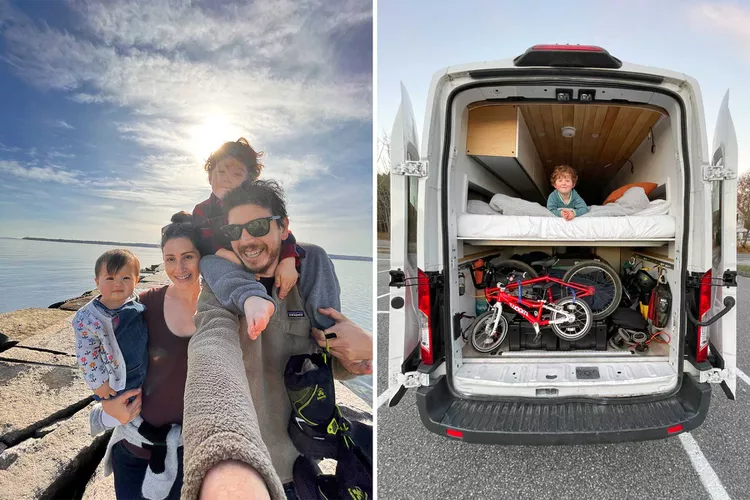Embracing Family Adventure: Our #Vanlife Journey
Our first day in the van didn’t go the way we’d hoped. My husband and I got a late start, and we only made it an hour from home before we had to pull over for burgers and to put our kids to bed. We were parked just off I-95, and our four-year-old, cramped in his new bunk bed, kept waking up his one-year-old sister. Then we realized we’d forgotten the sawdust for the composting toilet. (Whoops.) Still, after eight months of isolation in Connecticut, this late-fall family vacation to coastal Maine already felt like a major victory—one my husband and I celebrated by popping a bottle of champagne once Evie and Remy finally fell asleep.
If 2020 was the year when RVs, campers, and adventure rigs like ours, a Ford Transit outfitted by Live a Little Vans, captured the imagination of travelers across the country, 2021 is shaping up to be the year many of us actually make an RV vacation a reality. Rentals are rapidly becoming a top choice for long-distance road trips and national park visits. Jon Gray, CEO of RVShare, shares that the company reported an 80 percent increase in new users last year.
Moreover, RV companies like Outdoorsy have seen significant increases in interest. Co-founder and CEO Jeff Cavins stated, “We grew 400 percent year over year from 2018 to 2019, and in 2020, we doubled from the year before. We’re expecting to double again in 2021 based on current consumer intent.”
:max_bytes(150000):strip_icc():format(webp)/van-vacation-hero-VANVACAY0321-ef5894c1b1bc4060bd8340168097c1fa.jpg)
The possibilities have enticed not just solo adventurers but also a growing number of families. Sean Josephs, a fellow vanlife newcomer and co-founder of the small-batch whiskey brand Pinhook Bourbon, says the pandemic put him in an “if not now, when?” frame of mind. He and his wife, Mani Dawes, a co-owner of the restaurant Tia Pol in New York City, are planning a round-the-country journey with their three kids (12, 10, and 7) in 2021.
“The inevitable outcome of quarantining two entrepreneurs who love to travel—and are very accustomed to risk—is us finding an unconventional solution to getting back on the road,” he notes. They’ll be driving a Mercedes-Benz Sprinter 2500 van, customized by Gearbox Adventure Rentals, and “homeschooling” the kids from New Orleans, through the Southwest, up the Pacific Coast, then back east for the summer.
Our own maiden 10-day itinerary had no absolute must-dos beyond catching the sunrise from the top of Cadillac Mountain in Maine’s Acadia National Park. Planning too much seemed to defeat the point of our self-sufficient setup: with our own solar panels, kitchen, and even that composting toilet, we could spend the night pretty much anywhere. However, I was glad we’d made some preparations, like arranging to park overnight at In the Meadow Farm, an agritourism spot outside Boston, where the kids got to feed and pet the alpacas. Before you hit the road, here’s my unfiltered advice.
:max_bytes(150000):strip_icc():format(webp)/acadia-national-park-VANVACAY0321-16e110e5f46c48a3a1b0ec72d5e20e77.jpg)
Think Outside the Campground
Prime campsites at national parks often fill up many months in advance. Instead, consider options such as Harvest Hosts, which offers memberships to RV owners for access to over 1,800 overnight destinations, including farms, museums, and vineyards. >For those seeking unique private land with or without electrical hookups, Hipcamp provides a user-friendly platform. Furthermore, FreeRoam helps pinpoint public land available for off-the-grid “boondocking” stays. As we did, you can also call restaurants or breweries along your route to ask if they allow RV parking; many are happy to host visitors.
Prepare for Self-Reliance
There’s no escaping the basic realities of everyday living in a van. One constant chore on our trip was keeping our water tanks full. While service centers and Walmarts are reliable go-tos, we also found marinas and bike shops to be helpful. Finding dump sites for discarding gray water and emptying the toilet is also essential; Campendium served as our one-stop resource. If your van isn’t equipped with a shower—and you’d rather avoid busy campground facilities or gyms—the portable, electric Geyser is a must-have. A solar-powered energy bank from Goal Zero eliminates the need for a campground hookup. Those requiring Wi-Fi to stay connected (or to keep kids entertained with Netflix) should consider the robust cellular connection of WeBoost Drive X.
Leave Room for Spontaneous Adventure
There’s something about families embracing #vanlife that encourages locals to share their favorite offbeat destinations. During our time in Maine, I made sure to engage with residents as they pointed us to their favorites: a bowl of spicy night-market noodles at Long Grain in Camden, and the spectacular breakwater in Rockland Harbor. We discovered Rwanda Bean Coffee in Portland through the helpful website BlackOwnedMaine.com. We never drove more than two hours a day, and since we could always bed down in the van, we were free to make spur-of-the-moment detours to attractions like Fort McClary State Historic Site. Traveling impulsively expanded our horizons—we can’t wait to do it again.
A version of this story first appeared in the March 2021 issue of iBestTravel under the headline How We Pulled Off Our #Vanlife Adventure.




